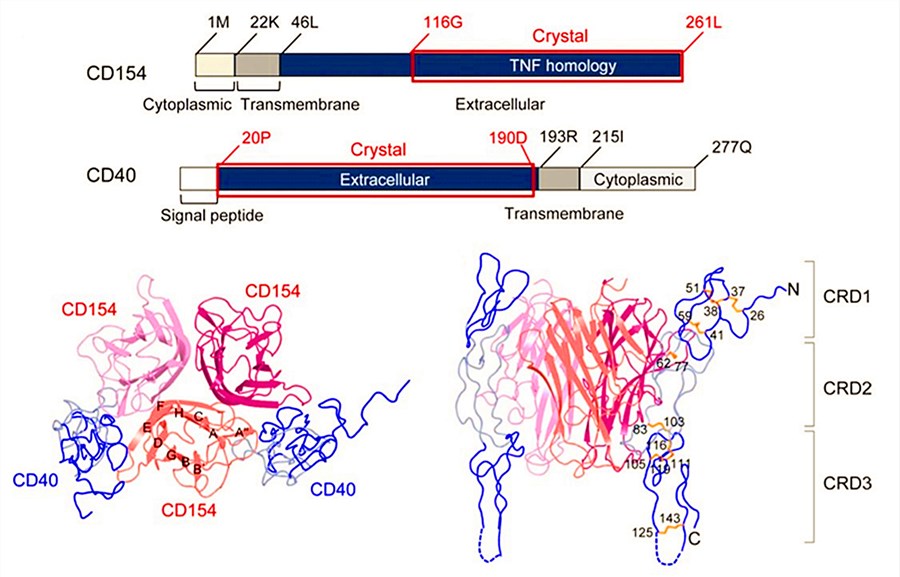CD40 (cluster of differentiation 40), also known as Bp50, CDW40, TNFRSF5, p50, is a type I transmembrane protein that can be found on a variety of antigen-presenting cells (APCs). CD40 plays a significant role in regulating cell activation, cell proliferation, cell survival, as well as cytokine production. CD40L (CD154, TNFSF5) has been regarded as the major binding partner for CD40. The binding of CD40/CD40L on B cells can provide a main helper T cell signal to promote isotype switching and antibody production. Moreover, a wide range of integrin receptors, such as αIIbβ3, α5β1, and αMβ2, have been identified that can interact with CD40/CD40L axis to facilitate their expression level and maintain enough immune responses.
| Checkpoint receptor | Alternate names | Cell type affected | Ligand | The function of ligand-receptor interaction |
| CD40 | Bp50, CDW40, TNFRSF5, p50, CD40 molecule | T cells, B cells, dendritic cells, macrophages | CD40L (CD154, TNFSF5) | Co-stimulatory |
CD40 is a 48-kDa co-stimulatory protein that consists of an extracellular domain, a leader sequence region, a transmembrane domain, an intracellular domain. Among them, 22 cysteine residues of CD40 in the intracellular domain are highly conserved and have more than 90% consistent with the TNFR superfamily. CD40L is a type II transmembrane protein with a molecular weight of 30-40 kDa. The CD40L structure contains one α-helix loop and two β-sheets to form a sandwich structure. The CD40 interaction region of one of the CD40L domains is much larger than other domains that include the binding fissure. Many reported have revealed that the CD40 CRD3 has a disulfide bond bridge in a rare area, altering the direction of the CD40 ladder structure. Also, The Ser (132) loop of CD40L is not associated with CD40 binding, but its variation can affect the p38- and ERK-dependent signaling pathways.
 Fig.1. Overall structure of the CD40-CD154 complex.1,2
Fig.1. Overall structure of the CD40-CD154 complex.1,2
Currently, CD40 is one of the most popular immune checkpoint molecules and has been widely used for drug development. Meanwhile, CD40/CD40L immune checkpoint can trigger both innate and adaptive immune responses by three main pathways, PI3K/AKT signaling pathway, MAPKs signaling pathway, and JAK3/STATs signaling pathway. Besides, many studies have illustrated that the binding and interaction between CD40 and its ligand CD40L play an important role in mediating T or B cell activation, tissue inflammation, as well as cell apoptosis. As a consequence, CD40/CD40L molecule has been treated as a potential immunotherapy target.
Up to now, many attempts have been made to develop novel CD40/CD40L-targeted drugs for various disease treatments. A number of drugs, such as antibodies and small-molecule drugs, have been designed and assessed in pre-clinical trials and early-stage clinical trials for the treatment of cancers and autoimmune diseases. To develop a new class of immune checkpoint-based drugs, Creative Biolabs has established a well-mature CD40/CD40L immune checkpoint drug discovery platform to offer a complete CD40/CD40L solution service chain, ranging from CD40/CD40L analysis, various types of drug design, discovery to commercialization. To get more information, please contact us.
References
All listed customized services & products are for research use only, not intended for pharmaceutical, diagnostic, therapeutic, or any in vivo human use.
USA
Tel:
Fax:
Email:
Copyright © 2026 Creative Biolabs. All Rights Reserved.